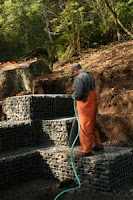The last time we looked, the concrete block crew had finished the first four feet of the walls, and poured grout (sloppy concrete) in all the cells.

They came back and laid up the remaining four feet, then there was some back and forth on just what constituted "stainless steel" rods anyhow. They had four nice shiny ones, but the next four were dull grey. However the shiny ones failed the "magnets do not stick to stainless" test, whereas the grey ones passed.
The magnet won over the shine and four more grey ones were brought in and the second grout pour could take place. Joey, from RK Concrete, in orange, presses the remote which controls the flow of grout. James helps weild the heavy hose, and Chris moves it from cell to cell.

With the pumping done, James makes the final adjustments to the bent plates (both shiny and stainless), and trowels off the grout smooth.

Chris has troweled these cells and does the final step of imbeding the anchor bolts ... on 16" centers! ... which will hold the first pieces of wood to the concrete block walls.

With the block walls quietly hardening up in the background, Aaron and Kenny returned to carry on with site work. The first of seepage trenches for the septic drain field gets dug. Kenny holds a survey rod, with a laser detector on it: it beeps a code telling whether it is above, level, or below the laser transit (the yellow thing perched on white tripod, beyond the tread of the excavator).

Into the trench goes 18" of drain rock, 4" pipe, 2" more of rock, filter fabic, and backfilled.

Chris, Tillamook County's On-site Sanitation Engineer, arrived a bit earlier than expected, but he patiently waiting for the last pipe to be laid....

... and then he signed off his approval. He and I hit it off when we learned that we overlapped in Aspen, and we played the "Oh, did you know so-in-so?" game for a while.

When the BIG FedEx truck arrived, I wondered, "FedEx?" and "How big a shipment are these things??"
Folded flat, and bundled on a pallet, why, pretty small.

But unfolded, and wired up, they are indeed large baskets, ready for rock to be placed in them.

In order to quickly see what all three levels will be like, we placed them on the west side, ignoring directions which advised completing the lowest row first, then next, etc.

I told Aaron that I did not think they were going to grow, but he thought it best to water them anyhow.



